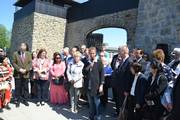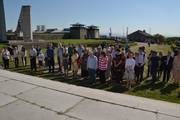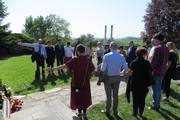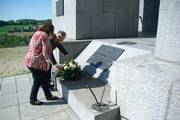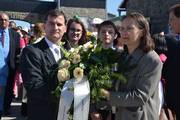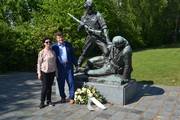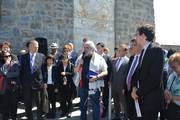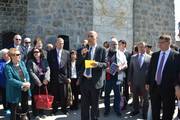Special Visits to the Memorial
08.03.2018
Encounter and interaction with visitors are features of the educational work of the Mauthausen Memorial. The encounters highlighted here will be remembered in particular.
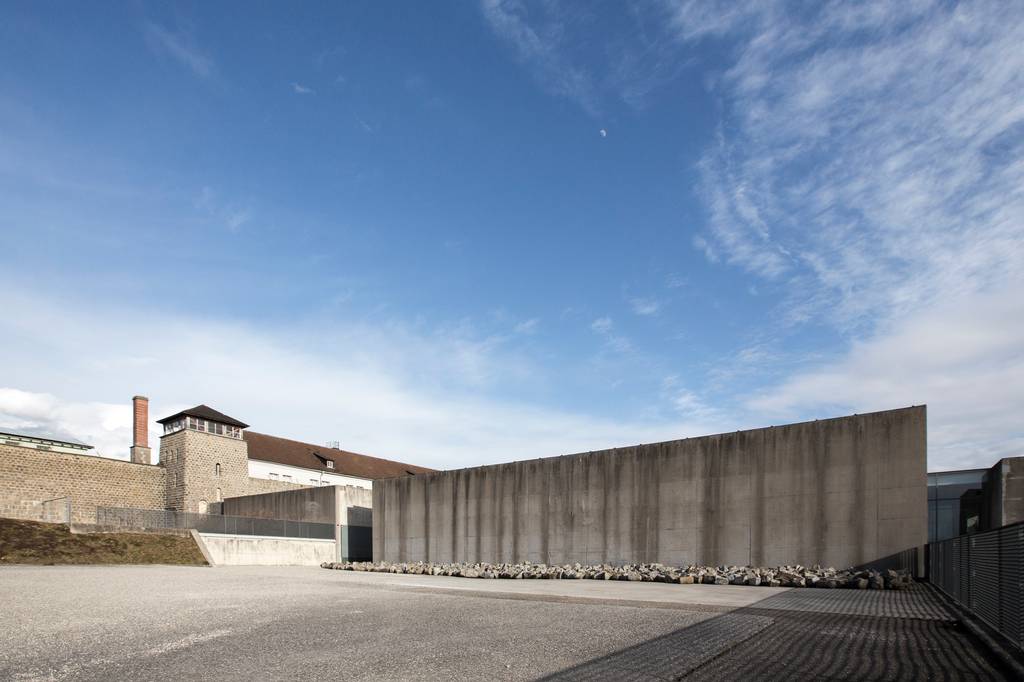
A visit to the Mauthausen Concentration Camp Memorial Site as part of the 'International Leadership Conference'
Following the two day "International Leadership Conference" in Vienna, which was attended by parliamentarians and religious leaders from over 40 countries, 150 of the guests paid a visit to the Mauthausen Concentration Camp Memorial.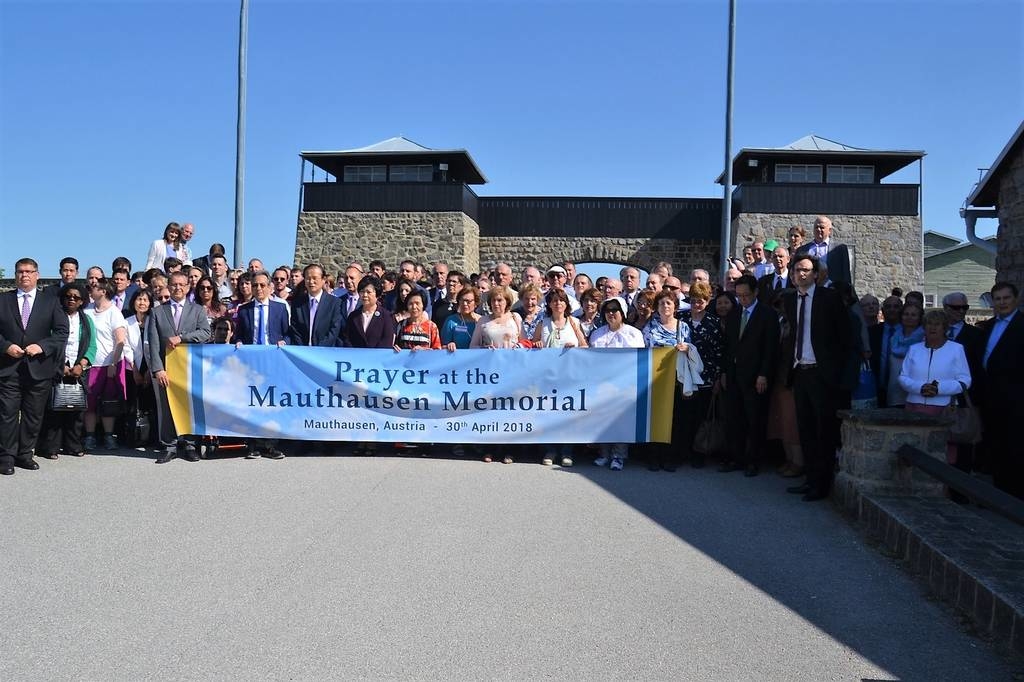 Parliamentarians and religious leaders from over 40 countries'. (Photo: UPF OÖ)
Parliamentarians and religious leaders from over 40 countries'. (Photo: UPF OÖ)
The group was greeted by Gudrun Blohberger, the educational director of the Concentration Camp Memorial Mauthausen, following which a prayer was offered by a rabbi from Russia and a pastor from the USA. A Spanish participant, whose grandfather had died in the Mauthausen camp, very movingly emphasized the power of forgiveness. To close, representatives of the individual nations laid bouquets of flowers at the Israeli, Polish, Russian, Hungarian, Albanian, French, Spanish, Italian, Dutch and German memorials.
03.02.2018
Natalia Egorova visits the Mauthausen Memorial
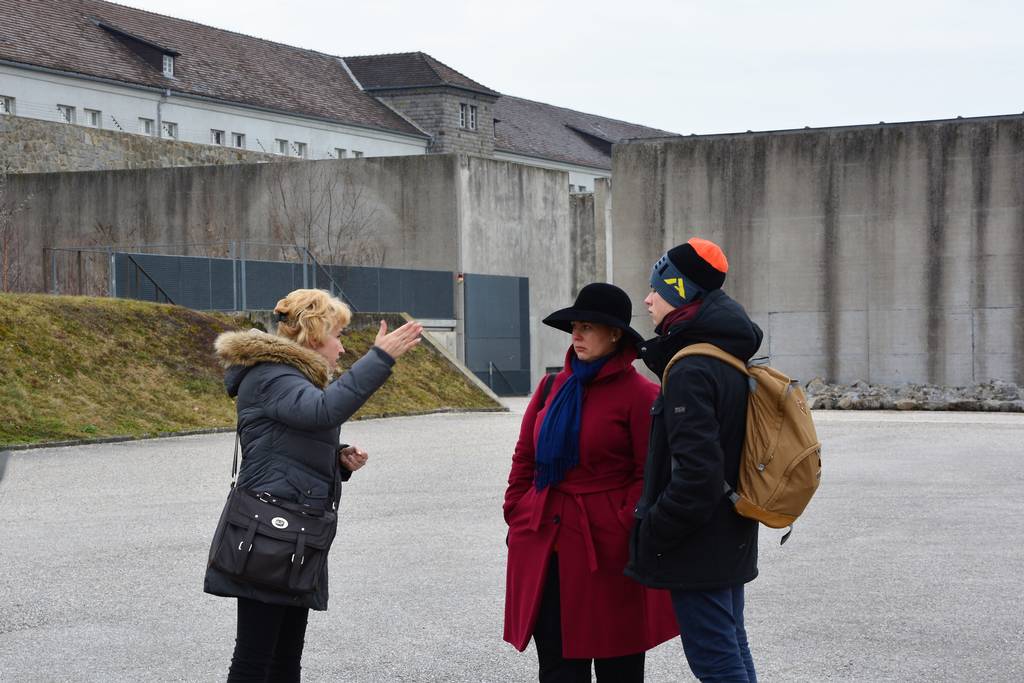 Natalia Egorova, the granddaughter of Evgenii Ivanovich Schukov, visited the Mauthausen Memorial together with her son. (photo credits: Mauthausen Memorial)On 3 February 2018, Mrs Natalia Egorova, the granddaughter of Evgenii Ivanovich Schukov, visited the Mauthausen Memorial together with her son. Schukov was taken a German prisoner of war in 1942 as a 20-year old lieutenant in the Red Army. After managing to escape for one day in the Stuttgart region, he was caught again on 10 May 1944 and transferred to Mauthausen concentration camp on 27 May 1944 as what was known as a ‘K’-prisoner. The term ‘K’-prisoner, standing for Kugel or bullet, was initially used for forced labourers who were accused of having carried out sabotage or political activities, but from 4 March 1944 it was also applied to prisoners of war, predominantly Soviet officers, who had had unsuccessful escape attempts. Until 23 May 1944 they were executed a few days after their arrival; after this date they were housed in Block 20, including Evgenii Schukov. Mistreatment, completely insufficient rations and appalling living conditions caused a large number of the ‘K’-prisoners, among them Evgenii Schukov, to die a wretched death.
Natalia Egorova, the granddaughter of Evgenii Ivanovich Schukov, visited the Mauthausen Memorial together with her son. (photo credits: Mauthausen Memorial)On 3 February 2018, Mrs Natalia Egorova, the granddaughter of Evgenii Ivanovich Schukov, visited the Mauthausen Memorial together with her son. Schukov was taken a German prisoner of war in 1942 as a 20-year old lieutenant in the Red Army. After managing to escape for one day in the Stuttgart region, he was caught again on 10 May 1944 and transferred to Mauthausen concentration camp on 27 May 1944 as what was known as a ‘K’-prisoner. The term ‘K’-prisoner, standing for Kugel or bullet, was initially used for forced labourers who were accused of having carried out sabotage or political activities, but from 4 March 1944 it was also applied to prisoners of war, predominantly Soviet officers, who had had unsuccessful escape attempts. Until 23 May 1944 they were executed a few days after their arrival; after this date they were housed in Block 20, including Evgenii Schukov. Mistreatment, completely insufficient rations and appalling living conditions caused a large number of the ‘K’-prisoners, among them Evgenii Schukov, to die a wretched death.
Block 20 is the block from which some 500 Soviet ‘K’-prisoners undertook an escape attempt in the night of 1-2 February 1945. Nearly all of those who fled were caught again. Most were murdered on the spot, the rest at the Mauthausen concentration camp. The SS were joined in the manhunt by the local gendarmerie, the Wehrmacht, the Volkssturm militia and a number of civilians from the surrounding area. Only eleven prisoners of war are believed to have survived this so-called ‘Mühlviertel Hare Hunt’, of whom eight are known by name.
15.10.2017
Visit to the Mauthausen Memorial by a group of 35 Roma from Burgenland and Vienna
On 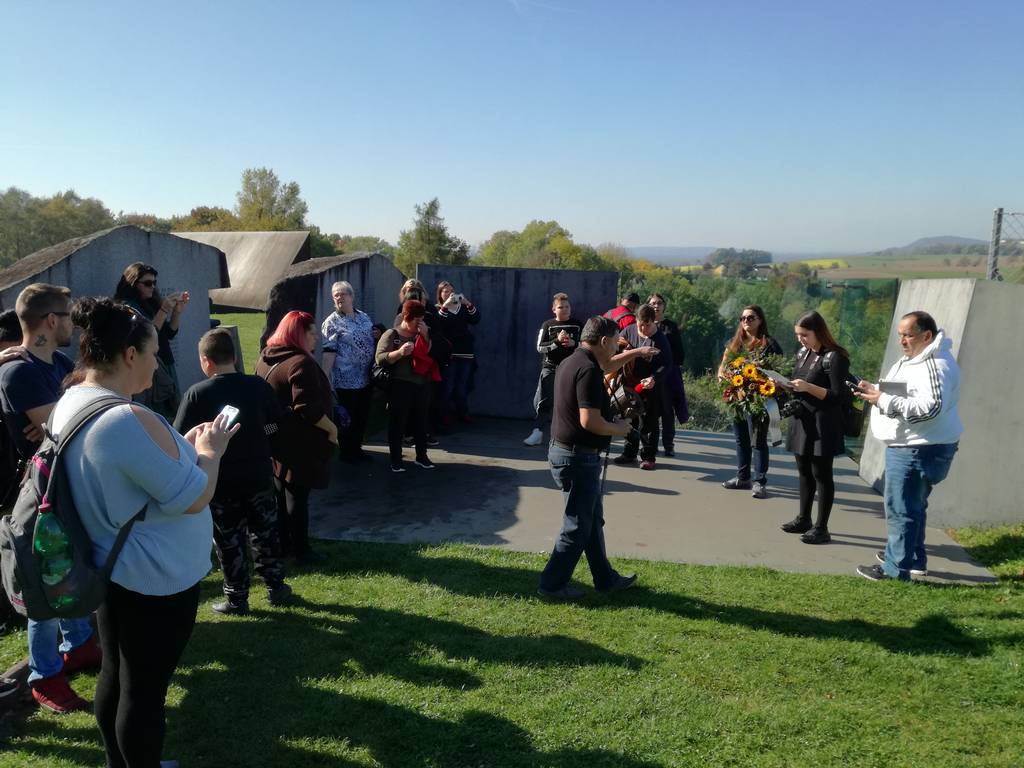 Visit by a group of Roma from Burgenland and Vienna (photo credits: Mauthausen Memorial)15 October 2017, Manuela Horvath paid a visit to the Mauthausen Memorial with a group of 35 Roma from Burgenland and Vienna. Manuela Horvath’s grandfather, Michael Horvath, survived several concentration camps and was liberated in Gusen on 5 May 1945. Around half the members of the group had a connection to Mauthausen, since many of their relatives were imprisoned or died here. During the guided tour a short commemorative service was held at the Memorial to the Murdered Roma and Sinti.
Visit by a group of Roma from Burgenland and Vienna (photo credits: Mauthausen Memorial)15 October 2017, Manuela Horvath paid a visit to the Mauthausen Memorial with a group of 35 Roma from Burgenland and Vienna. Manuela Horvath’s grandfather, Michael Horvath, survived several concentration camps and was liberated in Gusen on 5 May 1945. Around half the members of the group had a connection to Mauthausen, since many of their relatives were imprisoned or died here. During the guided tour a short commemorative service was held at the Memorial to the Murdered Roma and Sinti.
06.09.2017
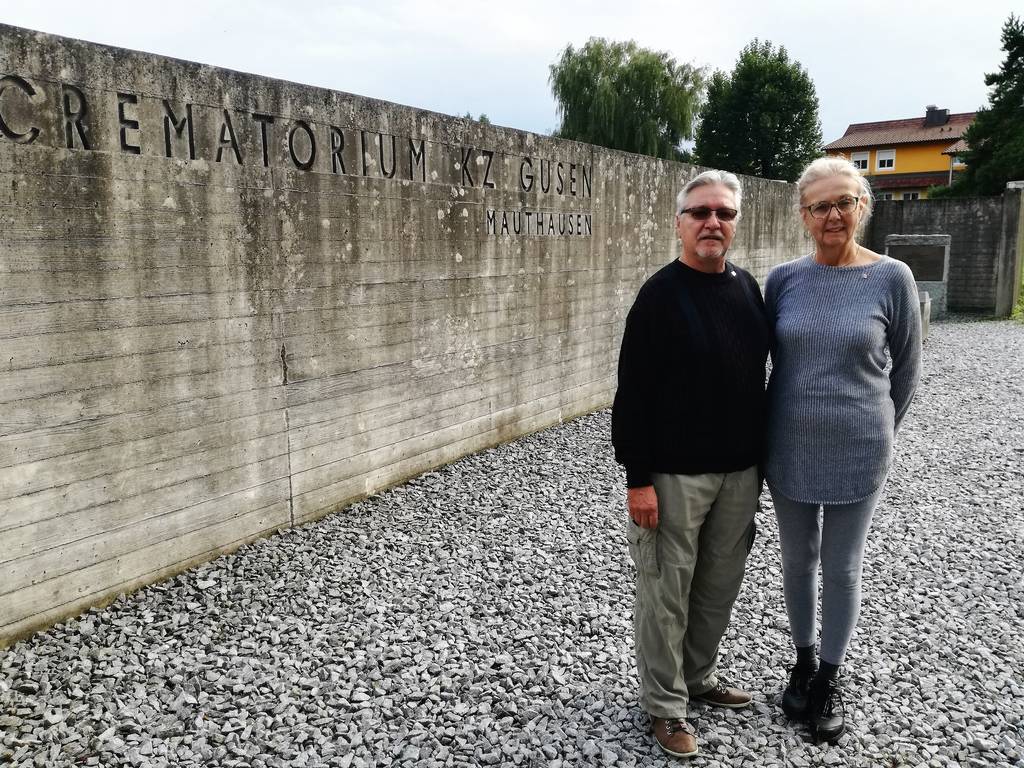 Johannes Dobbek and his wife at the Gusen Memorial (photo credits: Mauthausen Memorial)Visit by Johannes Dobbek and his wife at the Mauthausen and Gusen Memorial
Johannes Dobbek and his wife at the Gusen Memorial (photo credits: Mauthausen Memorial)Visit by Johannes Dobbek and his wife at the Mauthausen and Gusen Memorial
While tracing the history of his family, who were originally from Poland, Johannes Dobbek and his wife visited the Mauthausen and Gusen Memorials yesterday.
Johannes’s uncle, Albin Dobbek, was born on 24 August 1915 in Poland. He was later arrested and taken to the Gusen concentration camp, where he died on 3 August 1941. Johannes’s father survived imprisonment in a Stalag and later emigrated to Canada.
Archive
23.08.2017
Manuela Horvath visits the Mauthausen and Gusen Memorials
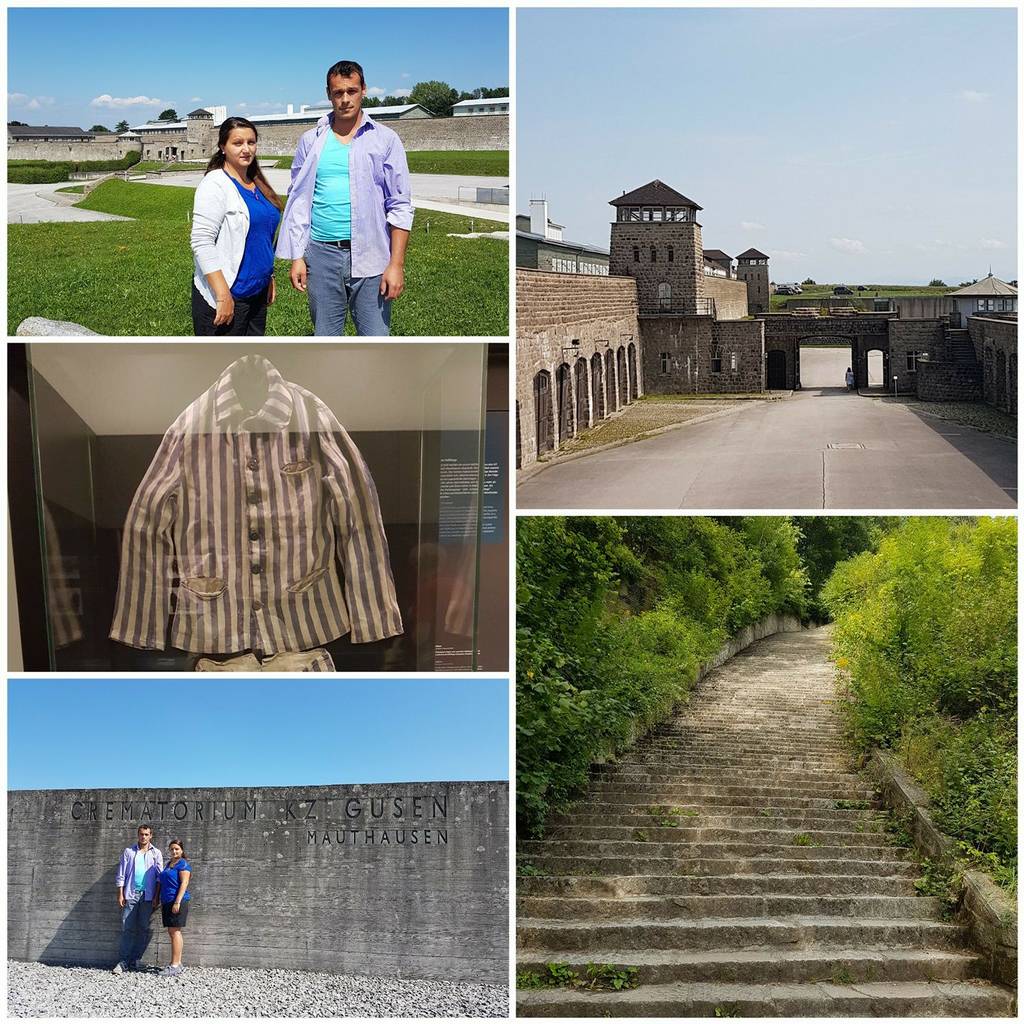 Visit of Michaela Horvath (photo credits: Mauthausen Mauthausen)On 24 August 2017, Manuela Horvath visited the Mauthausen and Gusen Memorials. Her grandfather, Michael Horvath, survived several concentration camps and was liberated on 5 May 1945 in Gusen.
Visit of Michaela Horvath (photo credits: Mauthausen Mauthausen)On 24 August 2017, Manuela Horvath visited the Mauthausen and Gusen Memorials. Her grandfather, Michael Horvath, survived several concentration camps and was liberated on 5 May 1945 in Gusen.
Michael Horvath was born on 2 January 1922 in Oberwart, Burgenland. The reason for his detention was that he was a member of the Roma ethnic community. On 26 June 1939 he was deported to the Dachau concentration camp. Three months later he was sent to Buchenwald, from where he was taken to Mauthausen in May 1941. Immediately after his arrival he was transferred to Gusen, where he was liberated four years later. The majority of his family did not survive deportation to the concentration camps.
On the night of 4 February 1995, four Roma men were murdered in a bomb attack in Oberwart, Burgenland. Among the dead were two of the then ten-year-old Manuela’s cousins. A sign was found at the scene bearing the racist slogan 'Roma back to India'. Today it is on display in the permanent exhibition at the Mauthausen Memorial.
08.08.2017
The Mauthausen survivor Joseph Friedman visits the Mauthausen and Gusen Memorials
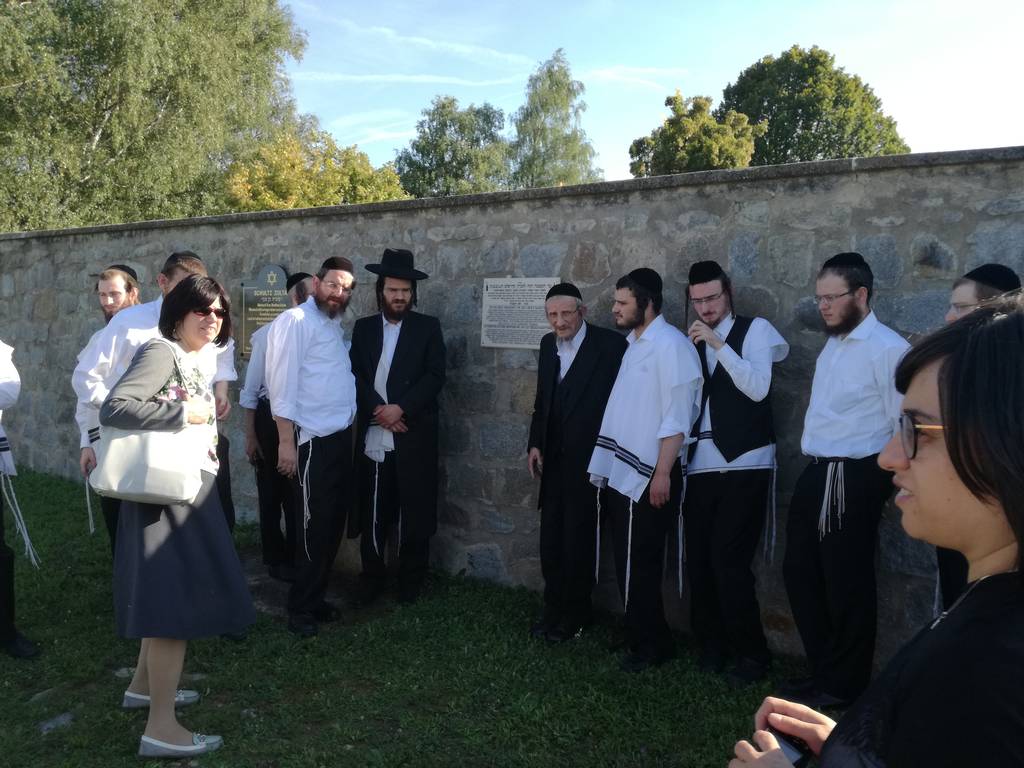 Joseph Friedman and his family at the Mauthausen Memorial (photo credits: Mauthausen Memorial)On the evening of 8 August 2017, Joseph Friedman, a survivor of the Mauthausen concentration camp, paid a spontaneous visit to the Mauthausen and Gusen Memorials accompanied by 16 members of his family.
Joseph Friedman and his family at the Mauthausen Memorial (photo credits: Mauthausen Memorial)On the evening of 8 August 2017, Joseph Friedman, a survivor of the Mauthausen concentration camp, paid a spontaneous visit to the Mauthausen and Gusen Memorials accompanied by 16 members of his family.
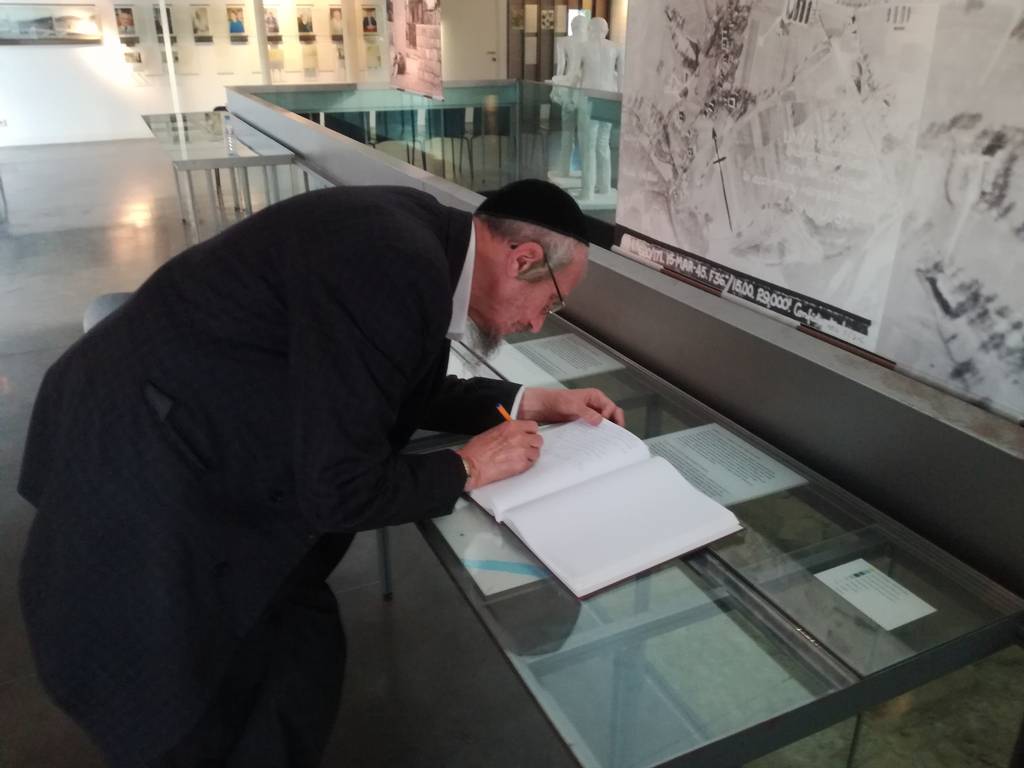 Joseph Friedman an der KZ-Gedenkstätte Gusen (Foto: KZ-Gedenkstätte Mauthausen)Born in Hungary, in 1944 Joseph Friedman was deported to the Munkács ghetto at the age of 14 along with his family. When the ghetto was cleared, the family was taken to Auschwitz, where he, his father and his older brother were selected to work as forced labourers and deported to Mauthausen. Joseph was transferred to the Gusen II concentration camp and his father and older brother were sent to the Ebensee concentration camp.
Joseph Friedman an der KZ-Gedenkstätte Gusen (Foto: KZ-Gedenkstätte Mauthausen)Born in Hungary, in 1944 Joseph Friedman was deported to the Munkács ghetto at the age of 14 along with his family. When the ghetto was cleared, the family was taken to Auschwitz, where he, his father and his older brother were selected to work as forced labourers and deported to Mauthausen. Joseph was transferred to the Gusen II concentration camp and his father and older brother were sent to the Ebensee concentration camp.
In March 1945 Joseph was brought to the so-called infirmary camp of the Mauthausen concentration camp, where he was liberated on 5 May 1945 at the age of 15. His brother was liberated in Ebensee the following day. Their father did not survive Ebensee.
13.07.2017/14.07.2017
Visit by the director of the International Tracing Service (ITS) to the Mauthausen Memorial and tour of the collections in Vienna
 From left to right: Barbara Glück, Floriane Hohenberg, Gudrun Blohberger (photo credits: Mauthausen Memorial)A meeting between Floriane Hohenberg, director of the International Tracing Service (ITS), and Barbara Glück, director of the Mauthausen Memorial, on 13 July 2017 at the Mauthausen Memorial offered an opportunity to exchange information and get to know one another.
From left to right: Barbara Glück, Floriane Hohenberg, Gudrun Blohberger (photo credits: Mauthausen Memorial)A meeting between Floriane Hohenberg, director of the International Tracing Service (ITS), and Barbara Glück, director of the Mauthausen Memorial, on 13 July 2017 at the Mauthausen Memorial offered an opportunity to exchange information and get to know one another.
As a documentation centre for National Socialist persecution, the ITS offers those who were persecuted and their descendants the possibility of researching imprisonment, forced labour and postwar assistance by the Allies.
Ralf Lechner, Floriane Hohenberg (photo credits: Mauthausen Memorial)The ITS has now made scans and metadata on people deported to the Mauthausen/Gusen concentration camp and to the subcamps available to the Mauthausen Memorial.
The digital copies allow the academic staff to carry out research in this document collection much more efficiently and, in the near future, the files will also be accessible to visitors interested in the collections.
During the ITS director’s visit to Vienna on 14 July 2017, Ralf Lechner, director of the Collections of the Mauthausen Memorial, gave a tour of the museum’s holdings and current documentation projects.
28.06.2017
Visit by Moshe Porat, a survivor of the Mauthausen concentration camp, to the Mauthausen and Gusen Memorials
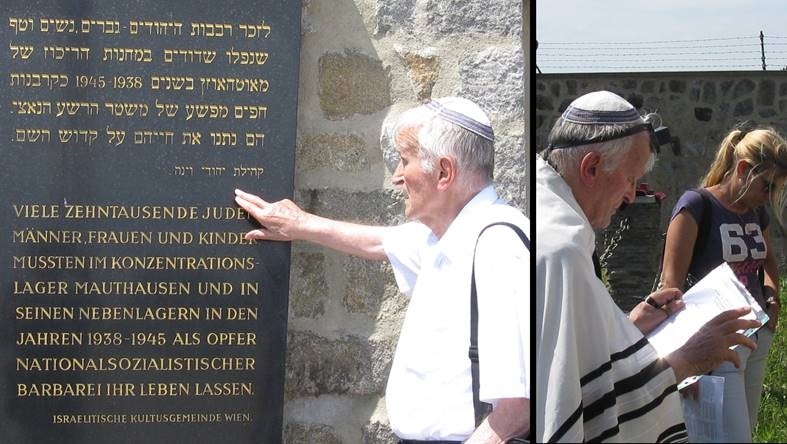 (photo credits: Mauthausen Memorial)On 28 June, Mauthausen survivor Moshe Porat visited the Mauthausen Memorial from Israel. It was the second time he and his wife had visited since 1985, but the first time in the company of his four daughters.
(photo credits: Mauthausen Memorial)On 28 June, Mauthausen survivor Moshe Porat visited the Mauthausen Memorial from Israel. It was the second time he and his wife had visited since 1985, but the first time in the company of his four daughters.
Born in Hajdúnánás in Hungary, his imprisonment began in spring 1944 in the Debrecen ghetto. When his deportation to Auschwitz was disrupted by partisans, Moshe, his mother and his four siblings were deported via Strasshof to the forced labour camp in Vienna’s Hackengasse for around 600 Hungarian Jews, the majority of them women and children. For ten months the then only 13-year-old Moshe was forced to clear rubble from bomb sites for use in rebuilding damaged houses. With the Red Army’s advance towards Vienna, the family was forced on a two-week death march to Mauthausen at the beginning of April 1945. Only 300 people from the transport arrived, utterly exhausted. Until the liberation on 5 May they were subject to the chaotic conditions in the main camp. Five weeks later, Moshe’s mother, Gisela Frisch, died from typhus in an American hospital in Gusen. The four children, aged 15, 13, 11 and 8, were now orphans since their father, a rabbi, had been killed in a forced labour camp in Graz. Their 18-year-old brother died on the day of his liberation from the Gunskirchen holding camp.
During a tour of the Mauthausen and Gusen memorials, Moshe spoke to his daughters about his experiences, recounting the memories that are also in his 1986 book “Triumph of Faith”. At the mass grave for the victims of Gunskirchen on the site of Block 19, the family said prayers in accordance with Jewish tradition in remembrance of their relatives who had been murdered.
23.06.2017
Pupils from St. John’s Preparatory School, Danvers, Massachusetts, visit the Mauthausen Memorial
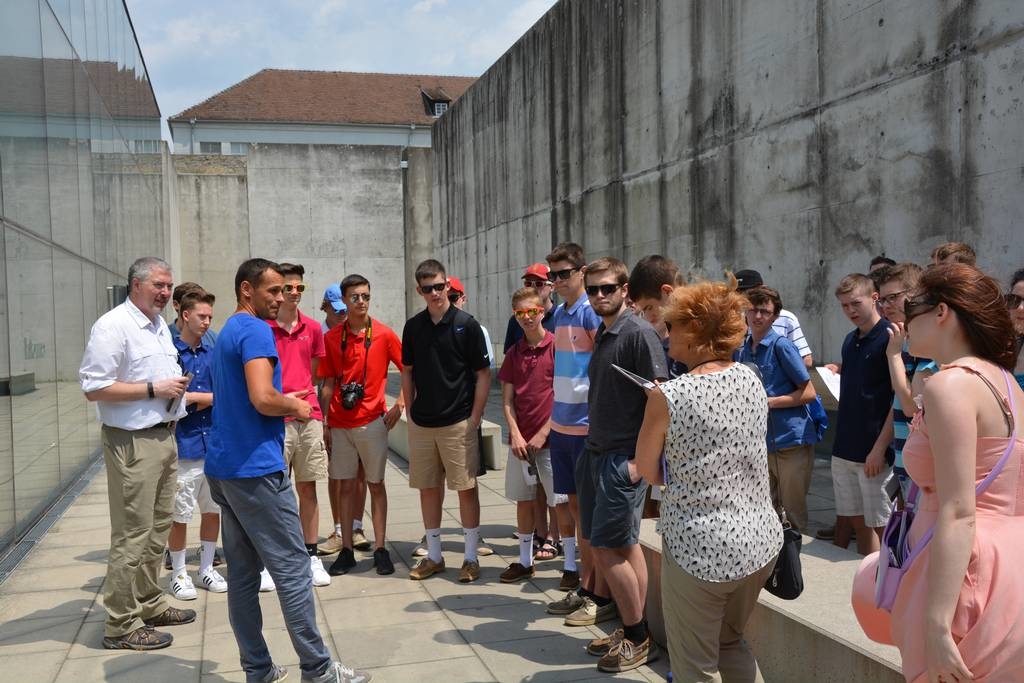 (photo credits: Mauthausen Memorial)On 23 June 2017, a group of pupils from St. John’s Preparatory School in Danvers, Massachusetts, visited the Mauthausen Memorial. The pupils were accompanied by Mrs Mary Kiley, who is the Holocaust Legacy partner of Sonia Schreiber Weitz.
(photo credits: Mauthausen Memorial)On 23 June 2017, a group of pupils from St. John’s Preparatory School in Danvers, Massachusetts, visited the Mauthausen Memorial. The pupils were accompanied by Mrs Mary Kiley, who is the Holocaust Legacy partner of Sonia Schreiber Weitz.
Sonia Schreiber Weitz was born in Krakow and, together with her sister, is a survivor of several concentration camps. On 5 May 1945, both sisters were liberated from the Mauthausen concentration camp. Most of the members of the Schreiber family were killed in the camps, including her father, who was murdered in Gusen on 3 February 1945.
Sonia Schreiber Weitz used the occasion of the visit to present the Mauthausen Memorial with a signed copy of her book. After a guided tour of the site, the group gathered at the Jewish Memorial to commemorate Jakub Schreiber, Sonia Schreiber Weitz’s murdered father.
21.06.2017
Donald Destatsbader visits the Mauthausen Memorial
For many years, Donald Destatsbader has been an active member of the organisation Harelbeke’s political prisoners. His father was a political prisoner who was also interned at the Flossenbürg concentration camp. During his visit to the Mauthausen Memorial, Mr Destatsbader and his party laid flowers at the Belgian Memorial in memory of Andrè Schaepdrijver, who died in Gusen.
01.06.2017
The Brett family visit the Mauthausen Memorial
Last Tuesday, Sandra Brett and her husband paid their first visit to the place where Sandra’s mother, Sarah Luel, and her mother’s sister, Raysa Luel, suffered so greatly. The two women, who were born in Poland, were deported to Mauthausen in 1945. Sarah survived and later emigrated to America. Her sister died in the days after the liberation of the camp. Bernhard Mühleder, a member of the Mauthausen education team, accompanied the couple on their tour of the Mauthausen Memorial.
21.04.2017
The Bukiet family visit the Mauthausen Memorial
Alter Szymon Bukiet was deported from the Płaszów-Krakow concentration camp to the Mauthausen concentration camp on 10 August 1944. Because he was classified as a specialist worker, he was forced to work in arms production. He was liberated on 5 May 1945 and then emigrated to America, where he died a few years ago. Bernhard Mühleder from the Mauthausen education team accompanied his son, Michael Bukiet, and his family during their visit to the Mauthausen Memorial.
19.04.2017
The Petja family visit the Mauthausen Memorial
Last week, the Petja family visited the Mauthausen and Gusen Memorials, accompanied by Klemens Knopp from the education team. Sulejman Dakoli, one of the family’s great-uncles, arrived at the Mauthausen concentration camp on 16 September 1944 as part of a transport of 780 prisoners from the Auschwitz concentration camp. At the Mauthausen camp he was classified as a ‘protective custody prisoner’ from Albania and was later transferred to the Gusen branch camp. According to the death register, Sulejman Dakoli died on 30 January 1945 in the Gusen concentration camp.
14.04.2017
The Navarro family visit the Mauthausen Memorial
For a long time, Juan Ortiz Navarro from Spain knew nothing about what had happened to his grandfather, Juan Ortiz Amo, who had disappeared without trace. It was only recently that it was discovered that he had died in Mauthausen. A member of the education team, Teres Stockinger, accompanied Juan Ortiz Navarro and his family during their visit to the Mauthausen Memorial.
06.09.2016
Daughter of a Holocaust survivor visits the Mauthausen and Gusen Memorials for the first time
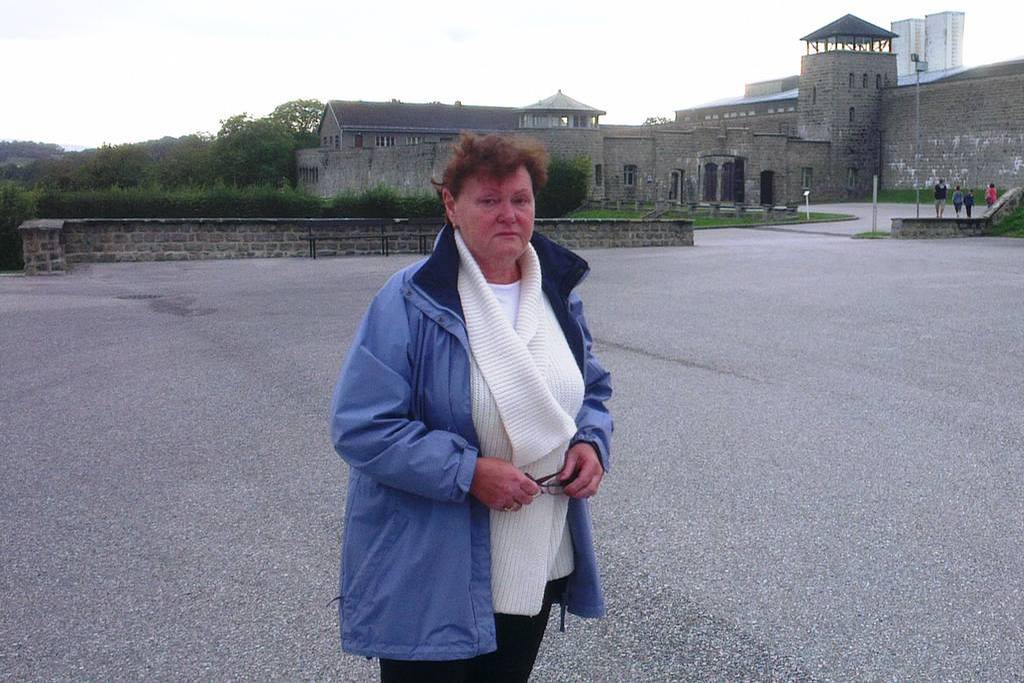 (photo credits: Mauthausen Memorial)Eugeniusz Boleslaw Ciepiela, born in 1928 in Mizyncu (then Poland, now Ukraine) was deported to the Gusen concentration camp at the age of 15. Later on he was transferred to the Mauthausen concentration camp, where, as a 19-year-old, he was liberated on 5 May 1945. His daughter Jadwiga Eugenia Kurianczyk visited the Mauthausen and Gusen Memorials for the first time today.
(photo credits: Mauthausen Memorial)Eugeniusz Boleslaw Ciepiela, born in 1928 in Mizyncu (then Poland, now Ukraine) was deported to the Gusen concentration camp at the age of 15. Later on he was transferred to the Mauthausen concentration camp, where, as a 19-year-old, he was liberated on 5 May 1945. His daughter Jadwiga Eugenia Kurianczyk visited the Mauthausen and Gusen Memorials for the first time today.
08.08.2016
Relatives of Salvador Olivé Saperas visit the Mauthausen and Gusen Memorials
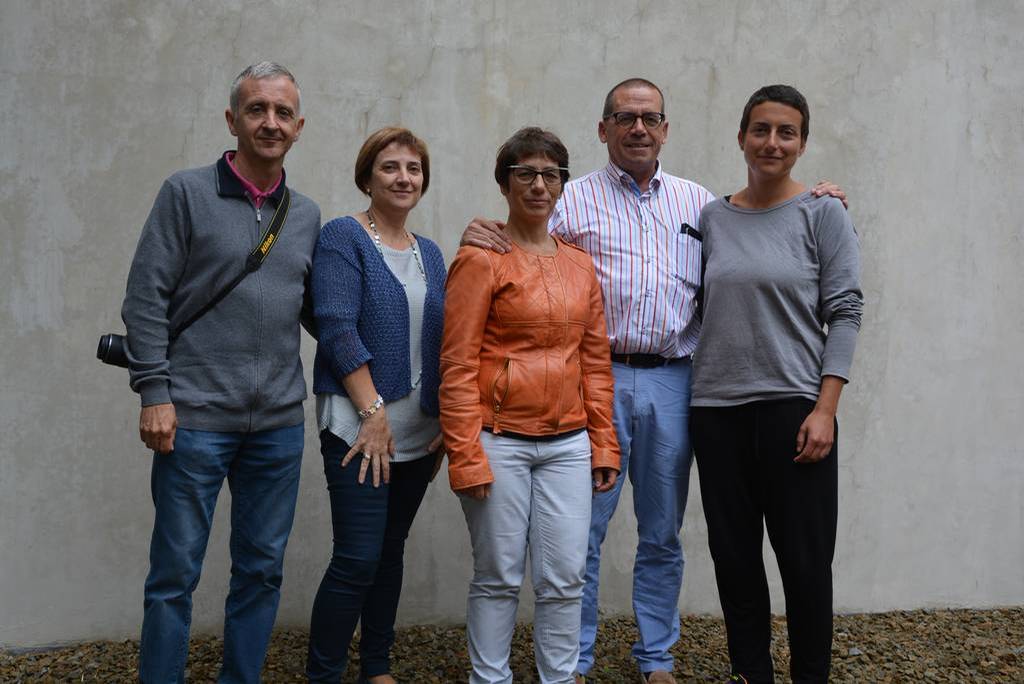 (Foto: KZ-Gedenkstätte Mauthausen)Born in 1902, Salvador Olivé Saperas was a bookkeeper and trade unionist in Barcelona. After the Spanish Civil War (1936-1939), he was one of the hundreds of thousands of people who fled Franco’s Spain for France. There, between 1940 and 1944, a total of 10,000 Spaniards were imprisoned by the National Socialists in concentration camps as so-called Red Spaniards. 7,000 of them were murdered by the SS.
(Foto: KZ-Gedenkstätte Mauthausen)Born in 1902, Salvador Olivé Saperas was a bookkeeper and trade unionist in Barcelona. After the Spanish Civil War (1936-1939), he was one of the hundreds of thousands of people who fled Franco’s Spain for France. There, between 1940 and 1944, a total of 10,000 Spaniards were imprisoned by the National Socialists in concentration camps as so-called Red Spaniards. 7,000 of them were murdered by the SS.
On 22 July 1941, Salvador Olivé Saperas was deported from a ‘Stalag’ (‘Stammlager’) prison camp to the Mauthausen concentration camp, and from there to the Gusen camp. The Gusen death registers record his date of death as 10 January 1943. These are the only pieces of information that the family has about their grandfather for the years 1939 to 1945.
Birgit Pichler, an educator at the memorial, greeted the guests. The group participated in a guided tour of the Mauthausen and Gusen Memorials.
04.08.2016
The survivor Eugeniusz Śliwiński visits the Mauthausen Memorial
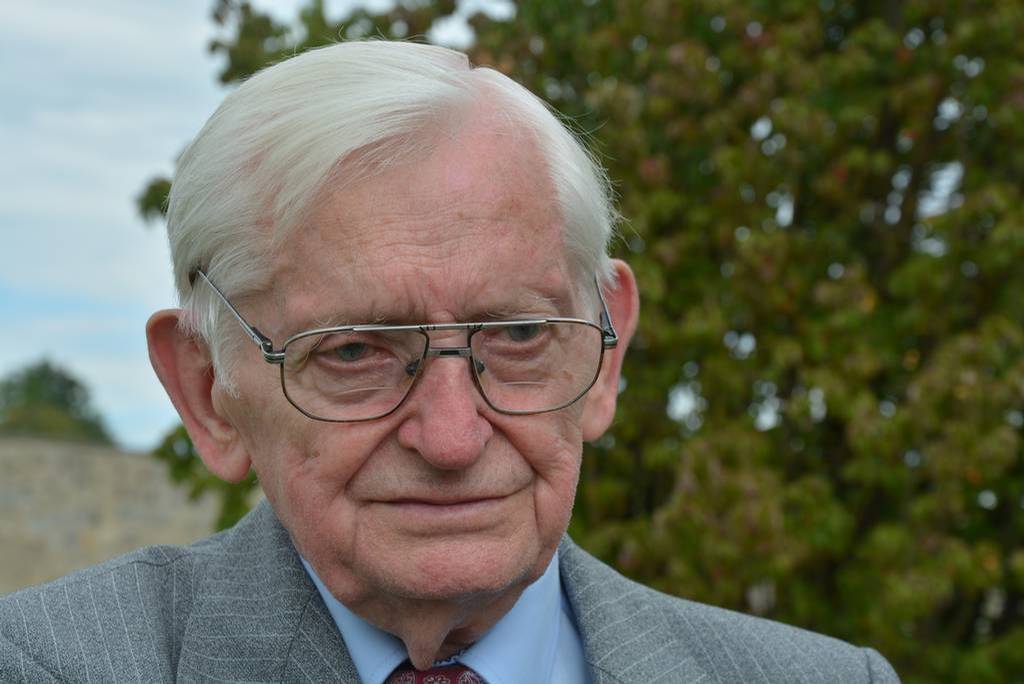 (photo credits: Mauthausen Memorial)Eugeniusz Śliwiński is 91 years’ old and is from Poland. He was imprisoned for two years and eight months in the Auschwitz, Mauthausen and finally Gusen I concentration camps. For a period he worked as a forced labourer in the Kastenhof Unterbruch quarry. He then succeeded in being transferred to a work detachment manufacturing arms for the Steyr-Daimler Puch company by pretending to be a cutter and metal-worker.
(photo credits: Mauthausen Memorial)Eugeniusz Śliwiński is 91 years’ old and is from Poland. He was imprisoned for two years and eight months in the Auschwitz, Mauthausen and finally Gusen I concentration camps. For a period he worked as a forced labourer in the Kastenhof Unterbruch quarry. He then succeeded in being transferred to a work detachment manufacturing arms for the Steyr-Daimler Puch company by pretending to be a cutter and metal-worker.
Eugeniusz Śliwiński was 19 years old when the Gusen camp was liberated.
12.07.2016
A survivor’s family visits the Mauthausen Memorial
On 12 July 2016 the Teperman family from Australia visited the Mauthausen Memorial. Their father and grandfather, Lejzor Teperman, and his brother Chaim Teperman were both imprisoned at the Mauthausen concentration camp in August 1944, having previously been in the Płaszów concentration camp in Poland. They only spent a few days in the Mauthausen concentration camp before being deported to different subcamps. They were both liberated in Ebensee.
The father of the three siblings – and the grandfather of the grandchildren who had travelled with them – rarely spoke about this period in his life. It was only during a visit to the Yad Vashem memorial museum that the family learned some of the details and started to track down the history.
Bernhard Mühleder, a member of the education team at the Mauthausen Memorial, greeted the guests. The family took part in a guided tour of the memorial museum. Barry Teperman, the oldest son, expressed his wish to repeat the visit in a few years’ time with his younger children.
10.07.2016
Mauthausen survivor Stella Esformes visits the Mauthausen Memorial
Stella Esformes was born on 15 April 1926 into a Jewish family in Salonikam in Greece. On 24 March 1944, she and her family were deported to Auschwitz, where her parents were murdered. Stella Esformes was selected for forced labour and deported to the Bergen-Belsen concentration camp in January 1945. From there she was deported to the women’s subcamp at Venusberg and finally to the Mauthausen concentration camp, where, suffering from typhus, she was housed in one of the barracks in the infirmary camp. On 5 May 1945, at the age of 19, she was liberated from the concentration camp by American soldiers.
Accompanied by her daughter, her son-in-law and her grandchild, Stella Esformes took part in a guided tour of the Mauthausen Memorial. With Teres Stockinger, a member of the education team, she also visited the museum and the current exhibitions and was greatly interested in the art exhibition ‘I am Yehuda Bacon. I never wanted to become a “concentration-camp-professional”’. This features works by the internationally renowned artist Yehuda Bacon, who was imprisoned in the Mauthausen concentration camp as a young man.
Stella Esformes was deeply moved by what are known as the Stairs of Death, one of the main sites of mass murder at the Mauthausen concentration camp.
15.06.2016
A Polish delegation visits the Mauthausen and Gusen Memorials
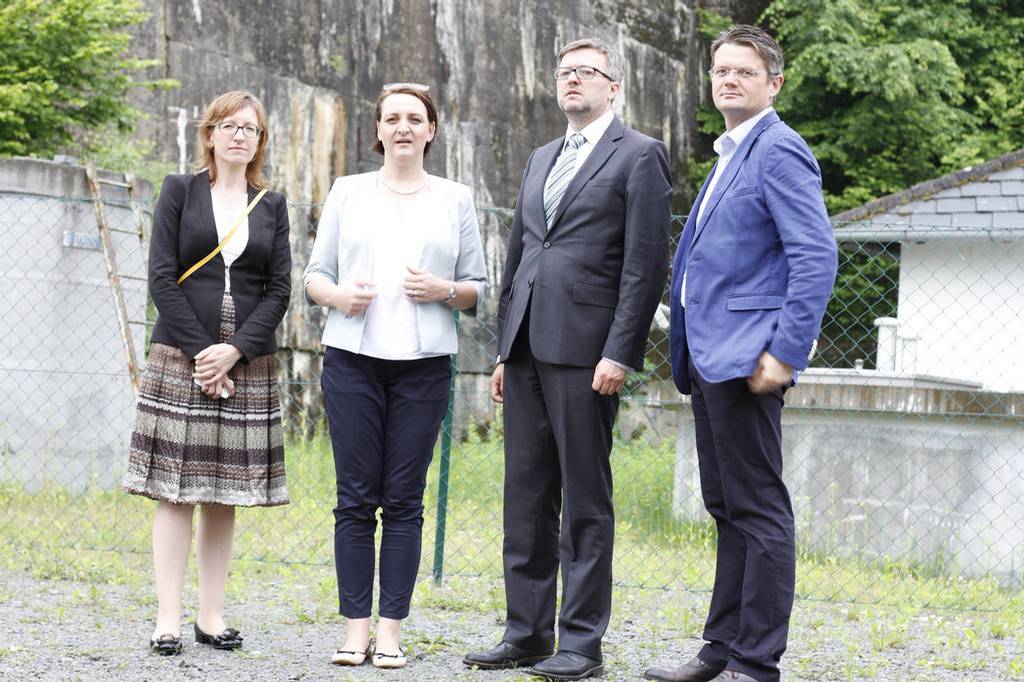 (photo credits: Mauthausen Memorial)A high-level delegation from Poland visited the Mauthausen and Gusen Memorials on 9 June 2016. Dr Magdalena Gawin, a parliamentary secretary, took the opportunity to learn about the history of the Mauthausen concentration camp system and about memorial culture in Austria. Over the course of several days, the delegation visited several former subcamps and spent a day in Mauthausen, Gusen and St. Georgen. Commemoration of Polish victims was also an important aspect of the trip.
(photo credits: Mauthausen Memorial)A high-level delegation from Poland visited the Mauthausen and Gusen Memorials on 9 June 2016. Dr Magdalena Gawin, a parliamentary secretary, took the opportunity to learn about the history of the Mauthausen concentration camp system and about memorial culture in Austria. Over the course of several days, the delegation visited several former subcamps and spent a day in Mauthausen, Gusen and St. Georgen. Commemoration of Polish victims was also an important aspect of the trip.
13.05.2016
A delegation from the Foundation ‘Remembrance, Responsibility and Future’ visits the Mauthausen Memorial
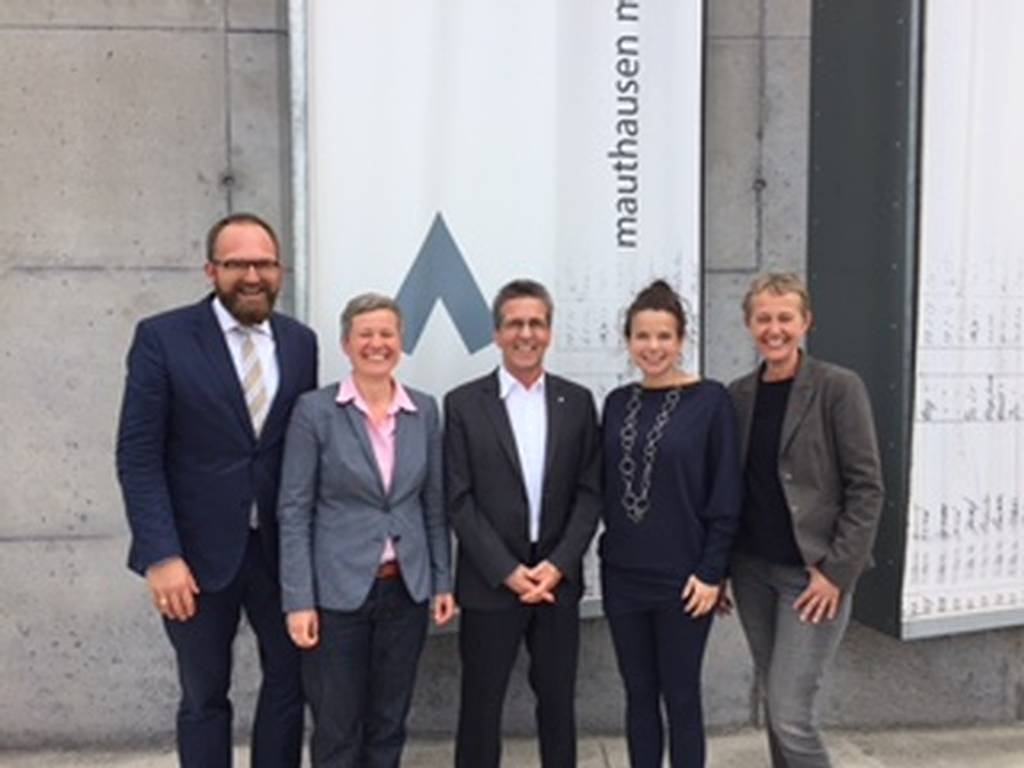 (Foto: KZ-Gedenkstätte Mauthausen)On 13 May 2016, a delegation of representatives from the Foundation ‘Remembrance, Responsibility and Future’, including its director, Günter Saathoff, visited the Mauthausen Memorial.
(Foto: KZ-Gedenkstätte Mauthausen)On 13 May 2016, a delegation of representatives from the Foundation ‘Remembrance, Responsibility and Future’, including its director, Günter Saathoff, visited the Mauthausen Memorial.
The guests were greeted by the director of the Mauthausen Memorial, DDr Barbara Glück and the head of the education team, Mag. Gudrun Blohberger. During a guided tour, the delegation learned about the current activities at the Mauthausen Memorial. A subsequent discussion on themes relevant to both institutions, for example human rights education, resulted in a recognition that both parties would be interested in cooperating on projects in this field. It was agreed that the two institutions would maintain closer contact in future.
The delegation’s visit to the Mauthausen Memorial has therefore laid the groundwork for potential cooperation projects in future with the Foundation ‘Remembrance, Responsibility and Future’.
19.04.2016
Holocaust survivor Onufriy Michailovich Dudok visits the Mauthausen Memorial
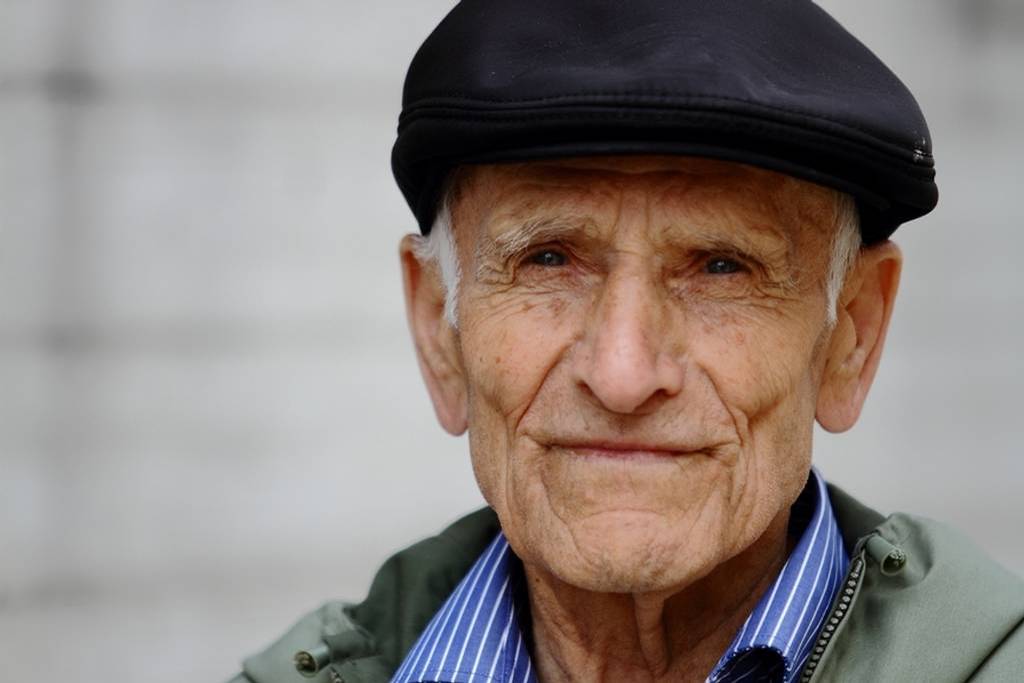 (photo credits: Mauthausen Memorial / Bernhard Mühleder)Onufriy Michailovich Dudok, born on 12 June 1926 in Kosowiec, Poland, visited the Mauthausen Memorial on 19 April 2016 with a delegation from the Flossenbürg Memorial. Mr Dudok was arrested in 1941 at the age of 15 because he had no identification on him. He was interned first in the Gestapo prison in Nuremberg and then transported to Auschwitz, before being imprisoned shortly afterwards at the Flossenbürg concentration camp. In 1944 Mr Dudok was transferred to the Mauthausen concentration camp. He spent a few weeks in quarantine in Block 20 and was then transferred to the Gusen concentration camp, where he was forced to work in different work detachments. He was liberated on 5 May 1945. He was 19 years old and suffering from extreme ill health as a result of imprisonment. He spent one and a half years receiving medical treatment before being able to return home. No one from his village was still expecting his return.
(photo credits: Mauthausen Memorial / Bernhard Mühleder)Onufriy Michailovich Dudok, born on 12 June 1926 in Kosowiec, Poland, visited the Mauthausen Memorial on 19 April 2016 with a delegation from the Flossenbürg Memorial. Mr Dudok was arrested in 1941 at the age of 15 because he had no identification on him. He was interned first in the Gestapo prison in Nuremberg and then transported to Auschwitz, before being imprisoned shortly afterwards at the Flossenbürg concentration camp. In 1944 Mr Dudok was transferred to the Mauthausen concentration camp. He spent a few weeks in quarantine in Block 20 and was then transferred to the Gusen concentration camp, where he was forced to work in different work detachments. He was liberated on 5 May 1945. He was 19 years old and suffering from extreme ill health as a result of imprisonment. He spent one and a half years receiving medical treatment before being able to return home. No one from his village was still expecting his return.
During his visit to the Mauthausen and Gusen Memorials, Mr Dudok was accompanied by Bernhard Mühleder, a member of the education team at both memorial museums.






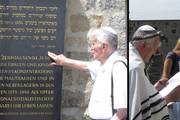
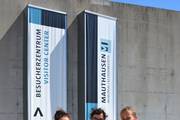
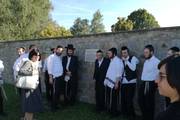
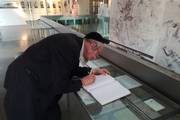
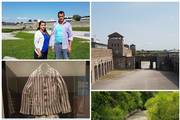
.jpg)
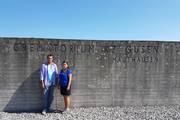
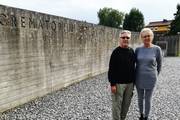
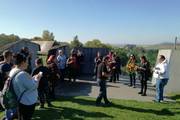
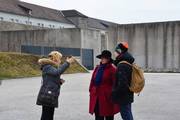
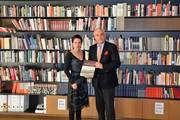
.jpg)
.jpg)
.jpg)
